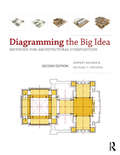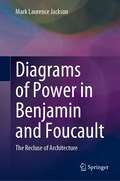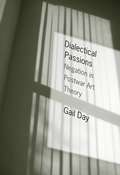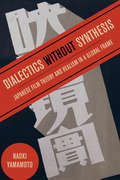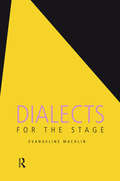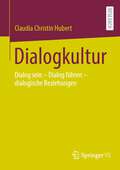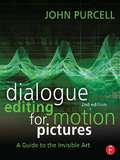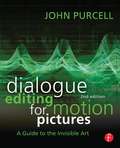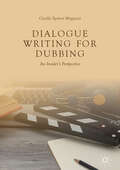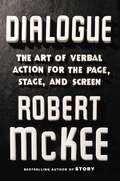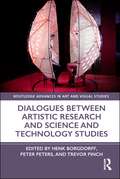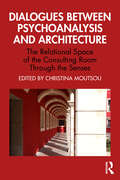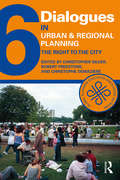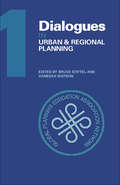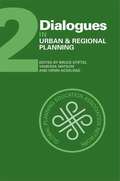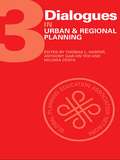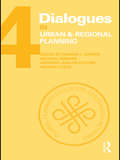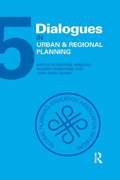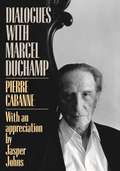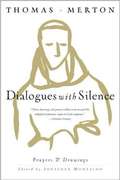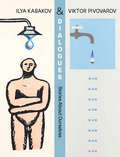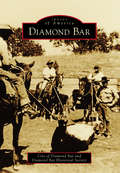- Table View
- List View
Diagramming the Big Idea: Methods for Architectural Composition
by Jeffrey Balmer Michael T. SwisherBecoming an architect is a daunting task. Beyond the acquisition of new skills and procedures, beginning designers face an entirely unfamiliar mode of knowledge: design thinking. In Diagramming the Big Idea, Jeffrey Balmer and Michael T. Swisher introduce the fundamentals of design thinking by illustrating how architects make and use diagrams to clarify their understanding of both specific architectural projects and universal principles of form and order. With accessible, step-by-step procedures that interweave diagrams, drawings and virtual models, the authors demonstrate how to compose clear and revealing diagrams. Design thinking defines a method for engaging the world through observation and analysis. Beyond problem solving, design is a search for possibilities. Mastering design thinking begins with learning the fundamentals of visual composition. It embraces the ability to synthesize deductive and imaginative reasoning, combining both shrewd scrutiny and fevered speculation. Design diagrams make visible the abstractions that order the built environment. Premised upon the Beaux-Arts notion of the architectural parti, Balmer and Swisher adopt the ‘Big Idea’ as a foil and as a suitcase to organize fundamentals of architectural composition. The goal of this book is to make explicit to students what they are learning, why they are learning it and how to internalize such lessons toward their lifelong development as designers.
Diagrams of Power in Benjamin and Foucault: The Recluse of Architecture
by Mark Laurence JacksonThis book’s overarching premise is that discussion and critique in the discourses of architecture and urbanism have their primary focus on engagements with form, particularly in the sense of the question as to what planning and architecture signify with respect to the forms they take, and how their meanings or content (what is “contained”) is considered in relation to form-as-container. While significant critical work in these disciplines has been published over the past 20 years that engages pertinently with the writings of Walter Benjamin and Michel Foucault, there has been no address to the co-incidence in the work of Benjamin and Foucault of an architectural figure that is pivotal to each of their discussions of the emergence of modernity: The arcade for Benjamin and the panoptic prison for Foucault have a parallel role. In Foucault’s terms, panopticism is a “diagram of power.” The parallel, for Benjamin, would be his understanding of “constellation.” In more recent architectural writings, the notion of the diagram has emerged as a key motif. Yet, and in as much as it supposedly relates to aspects of the work of Foucault, along with Gilles Deleuze, this notion of “diagram” amounts, for the most part, to a thinly veiled reinstatement of geometry-as-idea. This book redresses the emphasis given to form within the cultural philosophy of modernity and—particularly with respect to architecture and urbanism—inflects on the agency of force that opens a reading of their productive capacities as technologies of power. It is relevant to students and scholars in poststructuralist critical theory, architecture, and urban studies.“This is a book about Foucault and Benjamin and it is grounded in a deep knowledge of and reflection upon their works, but it is also underpinned by an impressive erudition. There are reflections on Hegel and Heidegger (central to the author) and Derrida, along with Kierkegaard, and others. This leads to a rich and suggestive discussion … in staging a spatial-architectural-political conversation between Foucault and Benjamin.”- Anonymous Reviewer“Mark Jackson’s Diagrams of Power in Benjamin and Foucault, The Recluse of Architecture juxtaposes and interrogates its two leading actors so as to draw from and through them a theory of architecture, which is inseparable from its recluse. In doing so it elaborates a series of complex connections with their various interlocutors and inspirations, Hegel, Heidegger, Derrida, the Kabbalah, Agamben, allegory, Marx, Deleuze, Klossowski, tragedy, capitalism, modernity, and so on. The list is long and impressive. This is not only done with an extremely high degree of scholarship, but is presented in a light, lucid and very compelling manner in a voice both personal and authoritative. The recluse is the figure of mimesis itself, the appearance of a withdrawal, always already a ruin. This book not only contributes a highly astute reading of its philosophical objects, but it enacts the ontology of the recluse through its own unfolding, simultaneously revealing and withholding the meaning of architecture ‘as such’, so that we not only understand its meaning, but feel the pulsing differential of the book’s object as if it were alive within us.”- Stephen Zepke, Independent Researcher, Vienna
Dialectical Passions: Negation in Postwar Art Theory
by Gail DayRepresenting a new generation of theorists who reaffirm the radical dimensions of art, Gail Day launches a bold critique of late-twentieth-century art theory and its often reductive analysis of cultural objects. Exploring core debates in discourses on art, from the New Left to theories of "critical postmodernism" and beyond, Day counters the belief that recent tendencies in art fail to be adequately critical and challenges the political inertia that results from these conclusions. Day organizes her defense around critics who have engaged substantively with emancipatory thought and social process: T. J. Clark, Manfredo Tafuri, Fredric Jameson, Benjamin H. D. Buchloh, and Hal Foster, among others. She maps the tension between radical dialectics and left nihilism and assesses the interpretation and internalization of negation in art theory. Chapters confront the claim that exchange and equivalence have subsumed the use value of cultural objects& mdash;and with it critical distance; the meaning of symbol and allegory in 1980s art and its limited reading of the writings of Walter Benjamin and Paul de Man; and common conceptions of mediation, totality, and the politics of anticipation. A necessary unsettling of received wisdoms, Dialectical Passions sets a new course for emancipatory reflection in aesthetics, art, and architecture.
Dialectical Passions: Negation in Postwar Art Theory (Columbia Themes in Philosophy, Social Criticism, and the Arts)
by Gail DayRepresenting a new generation of theorists reaffirming the radical dimensions of art, Gail Day launches a bold critique of late twentieth-century art theory and its often reductive analysis of cultural objects. Exploring core debates in discourses on art, from the New Left to theories of "critical postmodernism" and beyond, Day counters the belief that recent tendencies in art fail to be adequately critical. She also challenges the political inertia that results from these conclusions.Day organizes her defense around critics who have engaged substantively with emancipatory thought and social process: T. J. Clark, Manfredo Tafuri, Fredric Jameson, Benjamin H. D. Buchloh, and Hal Foster, among others. She maps the tension between radical dialectics and left nihilism and assesses the interpretation and internalization of negation in art theory. Chapters confront the claim that exchange and equivalence have subsumed the use value of cultural objects-and with it critical distance- and interrogate the proposition of completed nihilism and the metropolis put forward in the politics of Italian operaismo. Day covers the debates on symbol and allegory waged within the context of 1980s art and their relation to the writings of Walter Benjamin and Paul de Man. She also examines common conceptions of mediation, totality, negation, and the politics of anticipation. A necessary unsettling of received wisdoms, Dialectical Passions recasts emancipatory reflection in aesthetics, art, and architecture.
Dialectics without Synthesis: Japanese Film Theory and Realism in a Global Frame
by Naoki YamamotoDialectics without Synthesis explores Japan’s active but previously unrecognized participation in the global circulation of film theory during the first half of the twentieth century. Examining a variety of Japanese theorists working in the fields of film, literature, avant-garde art, Marxism, and philosophy, Naoki Yamamoto offers a new approach to cinematic realism as culturally conditioned articulations of the shifting relationship of film to the experience of modernity. In this study, long-held oppositions between realism and modernism, universalism and particularism, and most notably, the West and the non-West are challenged through a radical reconfiguration of the geopolitics of knowledge production and consumption.
Dialects for the Stage
by Evangeline MachlinDialect work is one of the actor's most challenging tasks. Need to know a Russian accent? Playing a German countess or a Midwestern farmhand? These and more accents – from Yiddish to French Canadian – are clearly explained in Evangeline Machlin's classic work. Now available in a book-and-CD format, Evangeline Machlin's Dialects for the Stage is based on a method of dialect acquisition she developed during her years working with students at Boston University's Division of Theatre. During her long career, Evangeline Machlin trained such actors as Steve McQueen, Lee Grant, Suzanne Pleshette, Joanne Woodward, and Faye Dunaway.
Dialogkultur: Dialog sein – Dialog führen – dialogische Beziehungen
by Claudia Christin HubertDialog ist ein Wort, mit dem jeder etwas anfangen kann. Doch wann führen wir einen Dialog? Wie kann eine oft geforderte Dialogkultur beschrieben werden? Dieses Buch gibt durch die kategoriegeleitete Analyse verschiedenster Theorien und Dialogkonzepten eine Antwort auf diese Fragen. Dabei werden Ansätze der Philosophie genauso betrachtet wie jene der Organisationssoziologie, der Kommunikationswissenschaften, der Soziologie, der Psychologie oder der Theologie - von Martin Buber über Marshall Rosenberg und Schulz von Thun bis hin zu Pierpaolo Donati, Carl Rogers und Papst Franziskus. Dabei werden die Gemeinsamkeiten der Ansätze ebenso dargestellt, wie die jeweiligen Spezifika. Es werden nicht nur die Handlungsweisen beschrieben, welche einen Dialog ausmachen, sondern auch die dahinterstehenden Annahmen über den Dialog, das zugrundeliegende Menschenbild, Werte und Normen. So bietet das Buch einen guten Überblick über die Dialogkultur und einen guten Einstieg in die Thematik.
Dialogue Editing for Motion Pictures: A Guide to the Invisible Art
by John PurcellProduce professional level dialogue tracks with industry-proven techniques and insights from an Emmy Award winning sound editor. Gain innovative solutions to common dialogue editing challenges such as room tone balancing, noise removal, perspective control, finding and using alternative takes, and even time management and postproduction politics. In Dialogue Editing for Motion Pictures, Second Edition veteran film sound editor John Purcell arms you with classic as well as cutting-edge practices to effectively edit dialogue for film, TV, and video. This new edition offers: A fresh look at production workflows, from celluloid to Digital Cinema, to help you streamline your editing Expanded sections on new software tools, workstations, and dialogue mixing, including mixing "in the box" Fresh approaches to working with digital video and to moving projects from one workstation to another An insider’s analysis of what happens on the set, and how that affects the dialogue editor Discussions about the interweaving histories of film sound technology and film storytelling Eye-opening tips, tricks, and insights from film professionals around the globe A companion website (www.focalpress.com/cw/purcell) with project files and video examples demonstrating editing techniques discussed in the book Don’t allow your dialogue to become messy, distracting, and uncinematic! Do dialogue right with John Purcell’s all-inclusive guide to this essential yet invisible art.
Dialogue Editing for Motion Pictures: A Guide to the Invisible Art (Second Edition)
by John PurcellIn Dialogue Editing for Motion Pictures, Second Edition, John Purcell arms you with classic as well as cutting-edge practices to effectively edit dialogue for film, TV, and video.
Dialogue Writing for Dubbing: An Insider's Perspective
by Giselle Spiteri MiggianiThis book analyses an important phase in the interlingual dubbing process of audiovisual productions: the elaboration of target language scripts for the recording studios. Written by a practitioner in the industry who is also an academic and trainer, it provides practical know-how and guidelines while adopting a scholarly, structural and methodical approach. Supported by an exemplified, analytical and theoretical framework, it is non-language specific and discusses strategies and tricks of the trade. Divided into three parts, the book provides a descriptive, practical and analytical approach to dubbing and dialogue writing. The author analyses scripts drawn from her own professional practice, including initial drafts that illustrate the various transformations of a text throughout the rewriting process. She also offers a ‘backstage’ perspective, from first-hand experience in recording sessions that enabled knowledge of text manipulation, studio jargon, and the dubbing post production process. This publication will provide a valuable resource for novice dubbing translators and dialogue writers, while offering practitioner insights to scholars and researchers in the field of Audiovisual Translation, Film and Media Studies.
Dialogue: The Art of Verbal Action for Page, Stage, and Screen
by Robert MckeeThe long-awaited follow-up to the perennially bestselling writers' guide Story, from the most sought-after expert in the art of storytelling. Robert McKee's popular writing workshops have earned him an international reputation. The list of alumni with Oscars runs off the page. The cornerstone of his program is his singular book, Story, which has defined how we talk about the art of story creation. Now, in DIALOGUE, McKee offers the same in-depth analysis for how characters speak on the screen, on the stage, and on the page in believable and engaging ways. From Macbeth to Breaking Bad, McKee deconstructs key scenes to illustrate the strategies and techniques of dialogue. DIALOGUE applies a framework of incisive thinking to instruct the prospective writer on how to craft artful, impactful speech. Famous McKee alumni include Peter Jackson, Jane Campion, Geoffrey Rush, Paul Haggis, the writing team for Pixar, and many others.
Dialogues Between Artistic Research and Science and Technology Studies (Routledge Advances in Art and Visual Studies)
by Trevor Pinch Peter Peters Henk BorgdorffThis edited volume maps dialogues between science and technology studies research on the arts and the emerging field of artistic research. The main themes in the book are an advanced understanding of discursivity and reasoning in arts-based research, the methodological relevance of material practices and things, and innovative ways of connecting, staging, and publishing research in art and academia. This book touches on topics including studies of artistic practices; reflexive practitioners at the boundaries between the arts, science, and technology; non-propositional forms of reasoning; unconventional (arts-based) research methods and enhanced modes of presentation and publication.
Dialogues between Psychoanalysis and Architecture: The Relational Space of the Consulting Room Through the Senses
by Christina MoutsouDialogues between Psychoanalysis and Architecture explores the multisensory space of therapy, real or virtual, and how important it is in providing the container for the therapeutic relationship and process. This book is highly original in bringing psychoanalysis and architecture together and highlighting how both disciplines strive to achieve transformation of our psychic space. It brings together contributions that comprise three parts: the first explores the space of the consulting room through the senses to examine issues such as smell and its link with memory and belonging, hearing out the Other, the psychoanalytic couch, the medical therapy room and the so-called sixth sense; secondly, the book questions how the consulting room can represent or be redesigned to reflect the philosophy that underlies the therapy process, foregrounding an architectural point of view; and thirdly, the book attends to the significance of the consulting room as a virtual space, as it emerged during the pandemic of COVID-19 and beyond. Architectural, psychotherapeutic and interdisciplinary perspectives allow for an important new dimension on the psychological use of space, and will appeal to psychoanalysts, psychoanalytic and integrative psychotherapists, art therapists, students of psychotherapy, as well as architects and designers.
Dialogues in Urban and Regional Planning 6: The Right to the City
by Christopher Silver Robert Freestone Christophe DemaziereThe Dialogues in Urban and Regional Planning series offers a selection of some of the best scholarship in urban and regional planning from around the world. The internationally recognized authors of these award-winning papers take up a range of salient issues from the theory and practice of planning. This 6th volume incorporates essays that explore the salient issue commonly referred to as "The Right to the City." This theme speaks to a growing new movement within planning theory and practice with multiple aims and strategies but with the common objective of advancing a more just and equitable world. The right to the city functions as a manifesto advancing academic explorations of the opportunities for, and barriers to, expanding human and environmental justice. At the same time, it extends beyond academic inquiry to engage directly with the policy, legal and political dimensions of human rights. The right to the city has been invoked by global bodies such as United Nations-Habitat and the United Nations Educational, Scientific and Cultural Organization to bolster not only their agendas around fundamental human rights but advance urban policies promoting inclusion, sustainability, and resilience. Dialogues 6 offers engaging explorations into the academic expeditions by the global planning community that have helped to energize this movement. The papers assembled here through processes of peer review represent an invaluable collection to untangle the complexities of this dynamic new approach to urban and regional planning. The Dialogues in Urban and Regional Planning (DURP) series is published in association with the Global Planning Education Association Network (GPEAN) and its member national and transnational planning schools associations.
Dialogues in Urban and Regional Planning: Volume 1
by Vanessa Watson Bruce StiftelDialogues in Urban and Regional Planning offers a selection of the best urban planning scholarship from each of the world's planning school associations. The award-winning papers presented illustrate the concerns and the discourse of planning scholarship communities and provide a glimpse into planning theory and practice by planning academics around the world. All those with an interest in urban and regional planning will find this collection valuable in opening new avenues for research and debate.This book is published in association with the Global Planning Education Association Network (GPEAN), and the nine planning school associations it represents, who have selected these papers based on regional competitions.
Dialogues in Urban and Regional Planning: Volume 2
by Vanessa Watson Bruce Stiftel Henri AcselradDialogues in Urban and Regional Planning offers a new selection of the best urban planning scholarship from each of the world's planning school associations. The award winning papers presented illustrate the concerns and the discourse of planning scholarship communities and provide a glimpse into planning theory and practice by planning academics around the world. All those with an interest in urban and regional planning will find this collection valuable in opening new avenues for research and debate.This book is published in association with the Global Planning Education Association Network (GPEAN), and the nine planning school associations it represents, who have selected these papers based on regional competitions.
Dialogues in Urban and Regional Planning: Volume 3
by Thomas Harper Heloisa Costa Anthony Gar-On YehThis is the third book in the series offering a new selection of the best urban planning scholarship from each of the world's planning school associations. The award winning papers presented illustrate the concerns and the discourse of planning scholarship communities and provide a glimpse into planning theory and practice by planning academics around the world. All those with an interest in urban and regional planning will find this collection valuable in opening new avenues for research and debate.
Dialogues in Urban and Regional Planning: Volume 4
by Thomas L. HarperDialogues in Urban and Regional Planning, Volume 4 is a selection of some of the best scholarship in urban and regional planning from around the world. The internationally recognized authors of these award-winning papers take up a range of salient issues from the theory and practice of planning. The topics they address include planning and governance in Zimbabwe, rebuilding after Hurricane Katrina, safety issues in urban spaces, and an analysis of French transportation policies. The breadth of the topics covered in this book will appeal to all those with an interest in urban and regional planning, providing a springboard for further debate and research. The papers focus particularly on how planning institutions can meet contemporary environmental, demographic, economic, and socio-spatial challenges. The Dialogues books are published in association with the Global Planning Education Association Network (GPEAN) and its member planning schools associations. These associations represent 360 planning schools in nearly fifty countries around the globe. They have selected these papers based on regional competitions.
Dialogues in Urban and Regional Planning: Volume 5
by Robert Freestone Michael Hibbard Tore Øivin SagerDialogues in Urban and Regional Planning 5 is a selection of some of the best scholarship in urban and regional planning from around the world. The internationally recognized authors of these award-winning papers take up a range of salient issues from the theory and practice of planning. The topics they address include the effects of globalization on world cities, metropolitan planning in France and Australia, and new research in pedestrian and traffic design. The breadth of the topics covered in this book will appeal to all those with an interest in urban and regional planning, providing a springboard for further debate and research. The papers focus particularly on themes of inclusion, urban transformation, metropolitan planning, and urban design. The Dialogues in Urban and Regional Planning (DURP) book series is published in association with the Global Planning Education Association Network (GPEAN) and its member national and transnational planning schools associations.
Dialogues with Marcel Duchamp
by Pierre Cabanne”Marcel Duchamp, one of this century’s pioneer artists, moved his work through the retinal boundaries which had been established with impressionism into t field with impressionism into t field where language, thought and vision act upon one another, <P><P>There it changed form through a complex interplay of new mental and physical materials, heralding many of the technical, mental and visual details to be found in more recent art...In the 1920s Duchamp gave up, quit painting. He allowed, perhaps encouraged, the attendant mythology. One thought of his decision, his willing this stopping. Yet on one occasion, he said it was not like that. He spoke of breaking a leg. ’You don’t mean to do it,’ he said.The Large Glass. A greenhouse for his intuition. Erotic machinery, the Bride, held in a see-through cage—’a Hilarious Picture.’
Dialogues with Silence
by Thomas MertonAn intensely personal devotional book from Thomas Merton, the ultimate spiritual writer of our time, showing his contemplative and religious side through his prayers and rarely-seen drawings. The only Merton gift book available. Dialogues with Silence contains a selection of prayers from throughout Merton's life--from his journals, letters, poetry, books--accompanied by all 100 of Merton's rarely seen, delightful Zen-like pen-and-ink drawings, and will attract new readers as well as Merton devotees. There is no other Merton devotional like this, and the paperback edition will be elegantly designed and packaged.
Dialogues with Silence
by Thomas MertonAn intensely personal devotional book from Thomas Merton, the ultimate spiritual writer of our time, showing his contemplative and religious side through his prayers and rarely-seen drawings. The only Merton gift book available.Dialogues with Silence contains a selection of prayers from throughout Merton's life--from his journals, letters, poetry, books--accompanied by all 100 of Merton's rarely seen, delightful Zen-like pen-and-ink drawings, and will attract new readers as well as Merton devotees. There is no other Merton devotional like this, and the paperback edition will be elegantly designed and packaged.
Dialogues: Ilya Kabakov and Vikor Pivovarov, Stories about Ourselves
by Tomas GlancArtists in the Soviet Union faced a difficult choice: either join the official academies and make art that conformed to the state’s aesthetic and ideological dictates, or attempt to develop alternative artistic practices and spheres for exhibiting their work. In the early 1970s, conceptual artists Ilya Kabakov and Viktor Pivovarov chose the latter option, turning their limited resources into an asset by pioneering an entirely new artistic genre: the album. Somewhere between drawings and novels, Kabakov and Pivovarov’s albums were also the basis for unique performance pieces, as the artists invited select audiences to their Moscow apartments for private readings and viewings of the albums, helping to cultivate an alternative artistic community in the process. This exhibition catalog brings together Kabakov and Pivovarov’s key works for the first time, putting the two artists in dialogue and recreating their artistic community. It not only includes nearly hundred pages of full-color illustrations, but also provides complete English translations of the Russian texts that appear in the volume, plus new interviews with each artist. Taken together, they give viewers a new appreciation of the different aesthetic strategies each artist used to depict the absurdities of everyday life in the Soviet era. Published in partnership with the Zimmerli Museum.
Diamond Bar
by City of Diamond Bar Diamond Bar Historical SocietyAs with many Southern California communities, Diamond Bar's recorded history began with a Spanish land grant. One of the area's first settlers was Jose de la Luz Linares, who founded Rancho Los Nogales (Ranch of the Walnut Trees) on the 4,340 acres granted to him by Mexican governor Juan Alvarado in 1840. The grant included Brea Canyon and the eastern Walnut Valley, a portion of which became the Diamond Bar Ranch, founded by Frederick E. Lewis II in 1918. In 1956, the area looked much as it did in 1840, its golden hills peppered with green stands of oak and walnut trees and grazed by large herds of cattle. In that year, the Transamerica Corporation paid $10 million for 8,000 acres of Brea Canyon, with plans to construct Southern California's largest master-planned community and name it Diamond Bar. Incorporated on April 18, 1989, the city of Diamond Bar is home to nearly 55,000 residents and is located at the crossroads of the Orange (57) and Pomona (60) Freeways on the eastern edge of Los Angeles County.
Diamond Quilts & Beyond: From the Basics to Dazzling Desgins
by Jan KrentzCreate Your own Gorgeous Quilt from Shimmering Diamonds! • Jan makes it easy to imagine, plan, and create your own beautiful art! • Let Impressionist paintings inspire you to try a colorwash look - with diamonds! • 4 projects help you gain the confidence to create a fabric masterpiece • Easy construction techniques • Lots of inspirational photos and a breathtaking gallery
